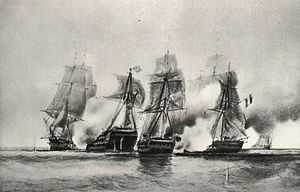Hilhouse
| Private | |
| Industry | Shipbuilding, Shipowner |
| Fate | Closed |
| Successor | Yard taken over by Charles Hill & Sons |
| Founded | 1772 |
| Defunct | 1845 |
| Headquarters | River Avon, UK |
Key people |
J.M. Hilhouse (founder), George Hilhouse (son), Charles Hill |
Hilhouse (also spelled Hillhouse) was a shipbuilder in Bristol, England who built merchantman and men-of-war during the 18th and 19th centuries. The company subsequently became Charles Hill & Sons in 1845.[1]
The company, and its successor Charles Hill & Sons, were the most important shipbuilders in Bristol,[2] and taking the concern together built over 560 ships over their 200 years of existence.
History
Origins
.jpg)

The shipbuilding concern Hilhouse and Company was first established in 1772[3] by James Martin Hilhouse, after inheriting a fortune from his father, James Hilhouse, a Bristol Sheriff and councillor who also ran a successful privateering venture. The company acquired the large Hotwells drydock, built by the engineer William Champion in 1765 on the north side of the River Avon, to build merchantman and undertake ship repair work. From 1778, Hilhouse secured Admiralty contracts for warships following the outbreak of the American Revolutionary War, including for the fourth rate Trusty.[4]
On 28 September 1785, Hilhouse launched the 1,406 tonne 64-gun Ardent-class ship of the line Nassau, which was the largest ship yet built in Bristol.[5] By 1786 they had built twelve warships of 3rd to 6th rates before orders became dominated by merchantmen.
Hilhouse and Company built ships
Major ships built by Hilhouse and Company:
- Exeter (1776), 300t West Indiaman.
- Medea (1778). 611t 28-gun sixth rate frigate.
- Cleopatra (1779). 689t 32-gun fifth rate frigate.
- Crescent (1779). 689t 28-gun sixth rate frigate.
- Mars (1779). 600t privateer frigate.
- Termagant (1780). 26-gun sloop.
- Arethusa (1781). 948t 38 gun fifth rate frigate.
- Trusty (1782). 1000t 50-gun fourth rate ship of the line.
- Serapis (1782). 900t 44-gun fifth rate frigate.
- Charon (1783). 900t 44-gun fifth rate frigate.
- Nassau (1785). 1200t 64-gun third rate ship of the line.
- Melampus (1785). 939t 36-gun fifth rate frigate.
- Severn (1786). 900t 44-gun fifth rate frigate.
- Pilgrim (1786). 306t merchantman.
- Marquis of Worcester (1787). 315t merchantman.
- Diomede (1795). 891t 44-gun fifth rate frigate.
- Fame (1801). 492t East Indiaman.
- Hope (1801). 216t merchantman.
- Concord (1801). 317t merchantman.
Hilhouse & Sons built ships
In 1803 the company became Hilhouse & Sons and Company[1] and expansion continued. By 1810, Charles Hill had joined the firm, and Hilhouse had acquired two further dockyards in city,[5] Wapping dockyard, near Prince Street in 1813, and Limekiln Dock, on Gasferry Lane on the north side of the river in 1820. In 1814 the company built the first steamboat in Bristol, the Charlotte and Hope.[6] In 1820 the company developed New Dockyard opposite the original site at Hotwells, what was to become the Albion Yard, and built two wet docks, a dry dock and building berths. This lead within 4 years to the closure of both the Wapping and Hotwells Dockyards.[5] The West Indiaman Weare of 446t was the first launch from the Albion Yard in 1820.
During the 1830s and 1840s William Patterson launched the ground breaking SS Great Western and SS Great Britain steamships in the adjacent Bristol dockyard, and the company subsequently lost out on important subsequent orders.[5]

Major ships built by Hilhouse & Sons and Company:
- Albacore (1804). 18-gun sloop-of-war.
- St Vincent (1804). 493t West Indiaman.
- Fame (1805). 401t merchantman.
- Nelson (1807). 580t West Indiaman.
- Severn (1807). 478t merchantman.
- William Miles (1808). 577t West Indiaman.
- Lady Carrington (1809). 471t merchant ship.
- Sarah (1810). 500t West Indiaman.
- Charlotte (1810). 427t West Indiaman.
- Bernard (1813). 468t merchantman.
- Princess Charlotte (1813). 411t merchantman.
- Charlotte and Hope (1814). Wooden paddle-wheel steamer.
- Kingston (1817). 431t merchantman.
- Henry Porcher (1817). 485t East Indiaman.
- Weare (1820). 446t West Indiaman.
- George IV (1821). 135t wooden paddle-wheel steamer.
- Viscount Palmerston (1821). 188t wooden paddle-wheel steamer.
- Hero (1823). 402t merchantman.
- Elphinstone (1825). 420t merchantman.
- Lord William Bentinck (1828). 564t East Indiaman.
- Elizabeth (1832). 445t merchantman.
- Orestes (1835). 529t East Indiaman.
- Princess Royal (1841). 462t merchantman.
- Duke of Cornwall (1843). 505t merchantman.
- Manuela (1843). 348t barque, the last ship built by Hilhouse.
Enter Charles Hill
In 1824 the company became George Hilhouse & Company, and the following year a young shipwright by the name of Charles Hill became a partner, eventually leading in 1840 to the name of the business becoming Hilhouse, Hill & Company.[5] Charles Hill subsequently took over running more and more of the business, and in 1845 he took sole control of the business and the firm became Charles Hill & Sons.
The Hilhouse built Albion Yard has continued in use up until this day, currently as Abels Shipbuilders.

Notes
- ↑ 1.0 1.1 "The Story of Charles Hill & Sons". Memories of Bristol England Past & Present. Archived from the original on 2007-07-02. Retrieved 2007-12-07.
- ↑ Farr, Graeme (1977). Shipbuilding in the Port of Bristol National Maritime Museum Maritime Monographs and Reports. p3
- ↑ "Charles Hill and Sons". Grace's Guides. Retrieved 2007-12-07.
- ↑ Winfield, Rif (2005). The 50-Gun Ship A Complete History Mercury Books. ISBN 1-84560-009-6. pp. 58-61
- ↑ 5.0 5.1 5.2 5.3 5.4 Hill, John (1981). Shipshape & Bristol Fashion. Bristol: Redcliffe. ISBN 0-905459-70-9. various
- ↑ "The Albion Dockyard". Bristol Railway Archive. Archived from the original on 2007-10-25. Retrieved 2007-12-07.
References
Hillhouse, Helen T. & Laurens Petigru (1959) Hillhouse.